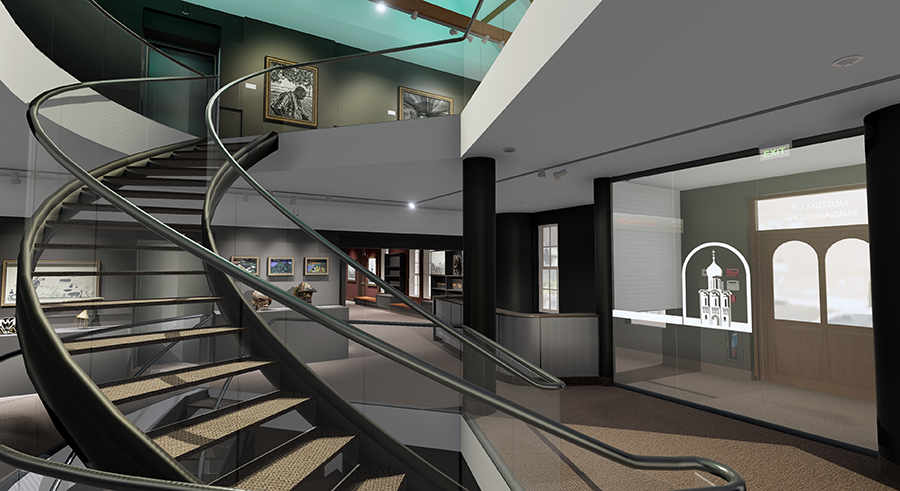An interactive digital design tool for galleries, libraries, archives, and museums has become the first ever humanities research from The University of Queensland to be commercialised and sold overseas.
The brainchild of Emeritus Professor Joanne Tompkins from UQ’s School of Communication and Arts, Ortelia’s innovative exhibition design software uses advanced 3D modelling technology to grant public cultural spaces a virtual presence.
It has been acquired by Zetcom Group AG, based in Bern, Switzerland, as an addition to its stable of cultural heritage sector software, including the MuseumPlus platform.
Zetcom boasts over 3000 customers, including the Louvre, the State Museums in Berlin and the National Heritage Board in Singapore, in more than 40 countries.

Ortelia emerged from research into theatre spaces conducted by Professor Tompkins over the last 2 and a half decades, with UQ’s commercialisation company UniQuest managing Ortelia’s interests over the years.
Founded after she won a UQ Foundation Excellence Award in 2001, Ortelia was originally intended for use by theatre companies.
Professor Tompkins said she always expected that the software generated to assist in the creation of theatre sets would be popular.
“While some theatres were interested, ultimately art galleries and museums spotted the niche that the software filled,” she said.
“Since then, Ortelia has become a trailblazing GLAM software company assisting over 150 galleries, museums, and industry consultants with 3D exhibitions design software and audience engagement applications in the cultural heritage sector.”
Ortelia, named for the early mapmaker, Abraham Ortelius, has provided services to the gallery and museum sector for almost 20 years.
The flagship product, Ortelia Curator, facilitates active exhibition design while offering a practical approach to archiving significant exhibitions.
The Curator tool increases efficiency for gallery and museum staff, streamlining the design of exhibitions.

Leveraging interactive 3D and 2D narrative-driven environments, Ortelia Interactive facilitates immersive virtual exhibitions that can be accessed across various platforms and devices, whether web, mobile, or desktop.
“Now, Curator’s link with Zetcom’s products will only further enhance the cultural heritage sector’s management of cultural space,” Professor Tompkins said.
Thanks to the two modellers, Lazaros Kastanis and Darren Pack, Ortelia took on clients including the UQ Art Museum, QAGOMA, as well as galleries further afield such as the Georgia O’Keeffe Museum in Santa Fe, New Mexico, and the Princess Diana Virtual Museum.
“During COVID, Ortelia’s services were in greater demand, even providing several American university programs with the means to create virtual spaces for their students to mount end-of-term exhibitions.”
While Ortelia took on numerous contemporary clients from around the world, Professor Tompkins continued to develop historically-inflected research, supported by Ortelia’s cutting-edge modelling expertise.
This has resulted in her most recent book, Visualising Lost Theatres: Virtual Praxis and the Recovery of Performance Spaces, co-authored with Julie Holledge, Jonathan Bollen, and Liyang Xia (Cambridge 2022).
“The book chronicles the research in recreating 5 theatres that no longer exist via virtual reality, and Ortelia built the models for these VR venues.”
In a move to facilitate research more widely rather than to profit from it, Professor Tompkins and the team have made the models freely available for download at www.losttheatres.net.

“This significantly innovative work continues to develop new features including enhanced sound in the VR models, and the creation of historically accurate avatars and costumes specifically designed for the venues.
“The generation of a new means of conducting historical research into theatre venues and the performance that took place in them is not being done elsewhere in the world.”
Executive Dean of UQ’s Faculty of Humanities, Arts and Social Sciences Professor Heather Zwicker said commercialising any product is hard, but it is even a bigger ask in the humanities.
“Ortelia is to be congratulated for achieving company status in the first instance, and then to have been sold to an overseas interest.
“This achievement suggests that the humanities can participate in a broader sphere of research activities,” she said.
Ortelia received an ARC Linkage Grant in 2005 and has contributed to the AusStage project, funded by LIEF grants.



